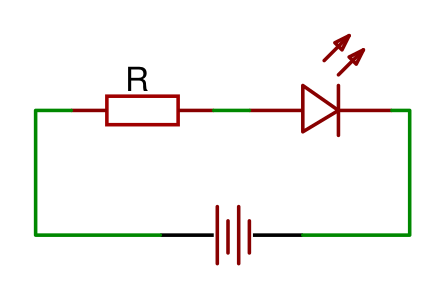Light emitting diode
An LED is a semiconductor that emits light. The light is emitted by the device when an electron combines with a hole. The color of the LED is determined by the size of the energy band gap. LEDs are made in many shapes and colors and are used in many consumer electronics as indicators.
Colors
LEDs can emit different colors of light. Red light has the least amount of energy and purple light has the most amount of energy. Higher amounts of energy correlate to a bigger voltage drop in the LED. You can find all values in the table below.
| color | wavelength (nm) | voltage-drop (V) |
|---|---|---|
| infrared | > 760 | < 1.63 |
| red | 610 - 760 | 1.63 - 2.03 |
| orange | 590 - 610 | 2.03 - 2.10 |
| yellow | 570 - 590 | 2.10 - 2.18 |
| green | 500 - 570 | 1.9 - 4.0 |
| blue | 450 - 500 | 2.48 - 3.7 |
| violet | 400 - 450 | 2.76 - 4.0 |
| ultraviolet | < 400 | 3 - 4.1 |
| pink | - | 3.3 |
| purple | - | 2.48 - 3.7 |
| white | - | 2.8 - 4.2 |
Resistors
LED resistor calculatorLEDs are very sensitive for overvoltage, so it is very important to use a resistor in series with the LED if the supply voltage is higher than the allowed voltage. The resistance of the appropriate resistor can be calculated with the following formula:

V source is the source voltage and is measured in volt (V)
V LED is the LED voltage and is measured in volt (V)
I LED is the LED current and is measured in ampere (A)
R is the symbol for resistance and is measured in ohm (Ω).
